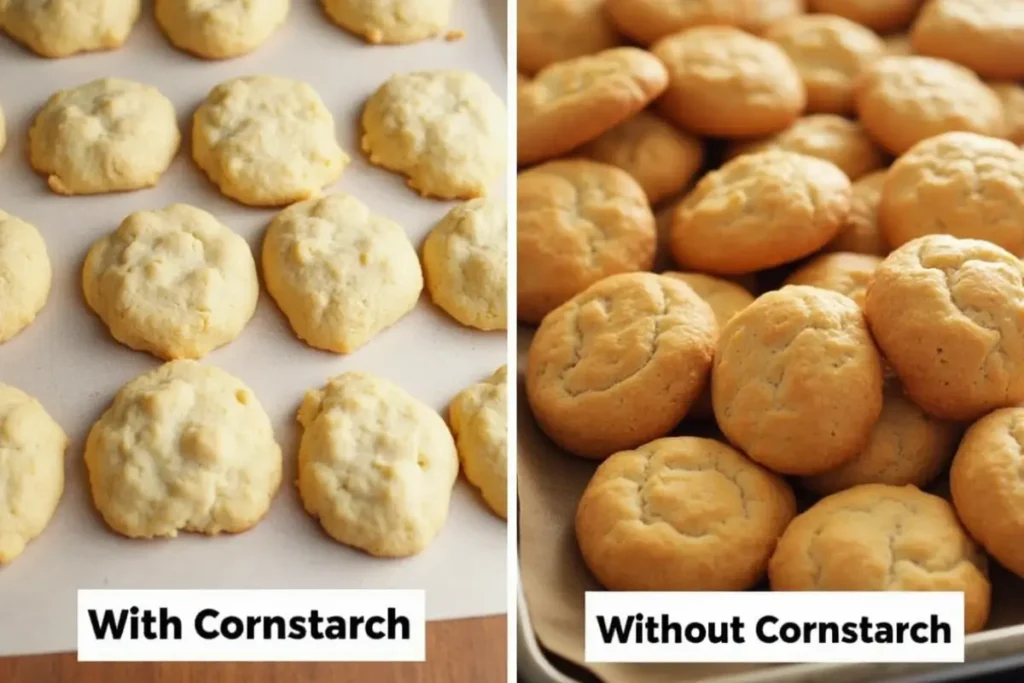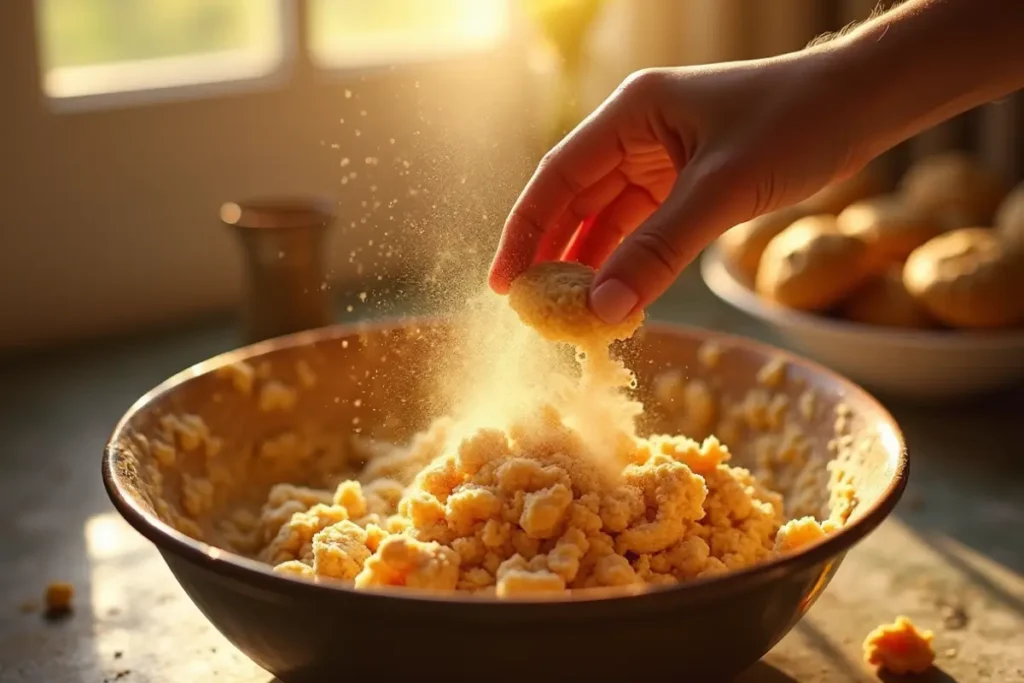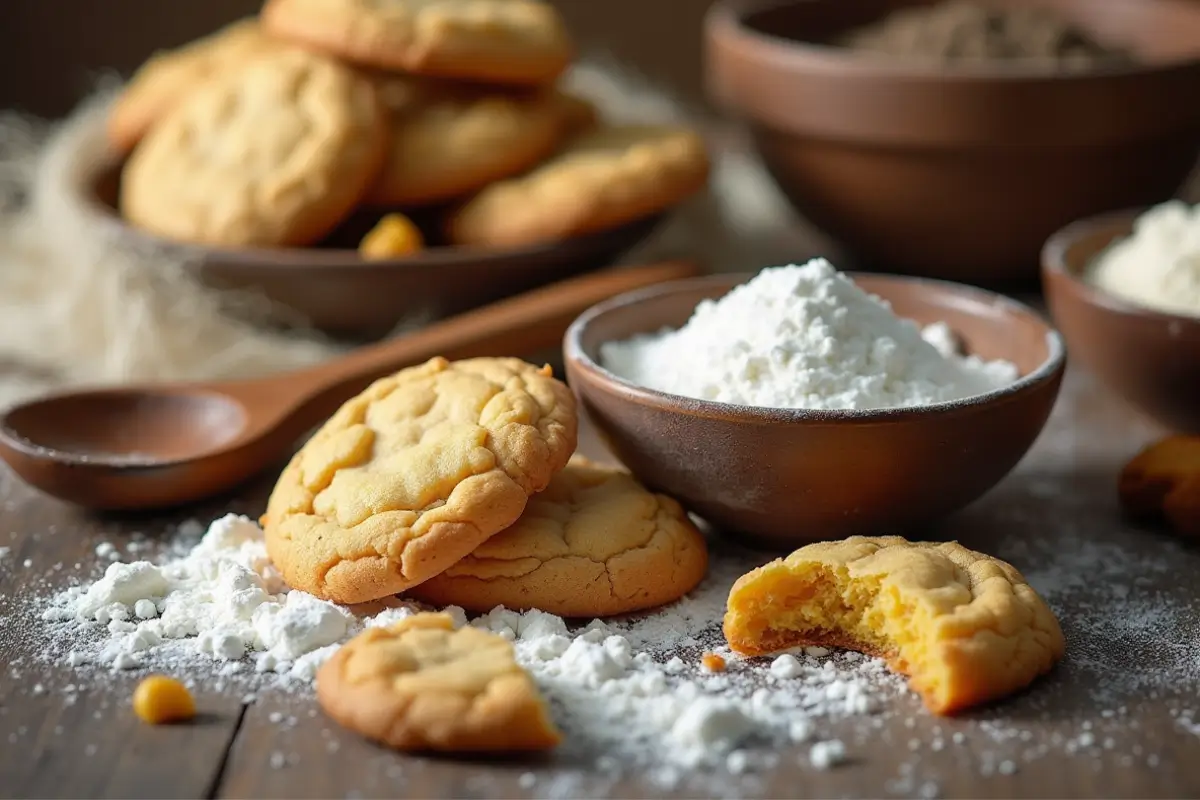Remember that feeling? That magical moment of biting into a perfect cookie? It’s a dance of crisp edges and a soft, chewy center. Indeed, the crumb melts in your mouth. I used to think it was a baking secret. Then, I discovered cornstarch. It’s a common kitchen item, often used to thicken sauces, but its potential in baking, especially when considering what does cornstarch do to cookies, is often overlooked. Have you ever wanted bakery-quality cookies at home? That perfect balance of texture and flavor seems impossible to replicate. Well, the difference often lies in one ingredient. Therefore, in this article, we’ll explore cornstarch. We’ll uncover how specifically it transforms cookies. We’ll examine the science behind it, how it affects texture, and how it elevates your baking.
The Science Behind Cornstarch in Cookies
Before appreciating cornstarch’s effect, you need to know what it is. Essentially, it’s a fine, powdery substance from corn kernels. Additionally, it’s made of long chains of glucose molecules. Now, when it meets moisture and heat, it transforms.
Think of it this way. Initially, cornstarch granules are in the liquid. Then, as cookies bake, moisture is absorbed. As a result, heat makes them swell and thicken. Thus, this creates a gel-like structure. In turn, this changes how other ingredients interact. Therefore, cornstarch’s properties contribute to desired qualities and perfect textures. Clearly, this behavior under heat makes it more than just a thickener.
How Cornstarch Improves Cookie Texture

Cornstarch’s impact on cookie texture is remarkable. In fact, it is truly a game-changer. It helps make soft, chewy cookies with a melt-in-your-mouth crumb. It moves beyond dense or crunchy results. Consequently, let’s see how it works.
Achieving a Softer, Chewier Center
One of the primary effects of cornstarch is a soft, chewy interior. Specifically, this is due to its interaction with gluten.
Gluten forms when flour mixes with water. Subsequently, it gives dough elasticity and structure. Notably, a crisp cookie needs more gluten. However, soft cookies need less. Cornstarch is key here. Indeed, it inhibits gluten development. It disrupts the formation of gluten strands. By diluting flour and absorbing moisture, it limits the gluten network. This means less of a tough structure and more chew. Therefore, less gluten means a softer cookie. The resulting texture is more tender than with just flour.
Creating a Tender, Crumbling Texture
Cornstarch’s fine, powdery structure also creates a delicate, crumbly texture. Fundamentally, it contributes to a short structure. This is desirable for an easy-to-break crumb. Moreover, its fine granules prevent dense cookies.
In addition to this, its powder helps break down dough structure. Accordingly, it prevents tough cookies. Cornstarch adds particles that separate ingredients. This ensures a more fragile structure. This, in turn, results in a more delicate and satisfying cookie. It has a fine crumb that is neither heavy nor dense. It ensures the cookie crumbles in your mouth, releasing amazing flavors.
Enhancing the Visual Appeal of Cookies
Aside from texture, cornstarch also enhances visual appeal. In particular, it affects how cookies spread. By reducing gluten, it helps cookies spread more evenly. In essence, as dough bakes, edges melt and the cookie flattens slightly.
You want even spread, not uneven or burnt edges. Adding cornstarch creates a stable baking environment. As a result, cookies spread evenly. They are visually appealing and consistent. Furthermore, they often develop puffed and cracked surfaces. This is all thanks to cornstarch’s effect on heat absorption.
Specific Ways to Use Cornstarch in Cookie Recipes
Knowing how cornstarch affects cookies lets you use it effectively. Manipulating recipes leads to better results. Therefore, it’s more than just adding a spoonful, so let’s explore how to use it.
Cornstarch as a Replacement for Flour
One of the most effective ways to use cornstarch is to replace some flour. Indeed, it’s common to use some cornstarch. Generally, one-quarter to one-half of the flour is best. Moreover, it works well in most recipes, without many changes.
For example, you can replace some flour with equal amounts of cornstarch. If a recipe needs 2 cups of flour, use 1 3/4 cups of flour and 1/4 cup of cornstarch. However, the ratio can vary. It depends on your recipe and preference. Generally, more cornstarch makes a chewier cookie. Thus, this is useful for tough or dry recipes. However, don’t replace all the flour. Cornstarch alone lacks structure. In effect, you need to find a perfect balance. Experiment with your recipes.
Cornstarch as an Enhancer for Other Ingredients
Beyond replacing flour, cornstarch can support other ingredients. It helps bind and keep moisture in the cookie. Indeed, this is helpful in various ways.
For example, cornstarch can enhance baking powder and baking soda. In particular, these need moisture. Cornstarch provides it. They work together for a more even rise. As a result, this creates a lighter texture. In addition, cornstarch helps retain moisture. Consequently, this improves flavors. By preventing moisture loss, flavors last longer. Thus, this ensures maximum flavor. It also prevents cookies from drying out. This is precisely why cornstarch is a good way to boost other ingredient performance.
Practical Tips for Using Cornstarch in Cookie Dough

Now that you know how cornstarch helps, let’s look at practical tips. Specifically, small baking adjustments can make a difference.
Firstly, measure cornstarch accurately. Too much can lead to dry cookies. Therefore, use measuring spoons and cups, and level them. Secondly, add cornstarch to dry ingredients. This ensures even distribution. Thus, whisk dry ingredients thoroughly before adding wet ones. Finally, the dough should be smooth. It should not have any powdery spots. If there are spots, mix slightly longer until they are incorporated. These tips help you use cornstarch fully.
Simple Cornstarch Cookie Recipe
To start with cornstarch cookies, here is a simple recipe:
Table: Ingredients for Simple Cornstarch Cookies
| Ingredient | Amount |
| All-purpose flour | 2 cups |
| Cornstarch | 1/4 cup |
| Unsalted butter | 1 cup (2 sticks), softened |
| Granulated sugar | 3/4 cup |
| Brown sugar | 3/4 cup |
| Large eggs | 2 |
| Vanilla extract | 1 teaspoon |
| Baking soda | 1 teaspoon |
| Salt | 1/2 teaspoon |
| Chocolate chips | 1 1/2 cups |
Instructions:
- Preheat the oven to 350°F (175°C). Prepare baking sheets with parchment paper.
- Whisk together flour, cornstarch, baking soda, and salt in a bowl. Set aside.
- Cream together butter, granulated sugar, and brown sugar in a large bowl. Make it light and fluffy.
- Beat in eggs one at a time. Stir in vanilla extract.
- Gradually add dry ingredients to wet ingredients. Mix on low speed until combined.
- Stir in chocolate chips.
- Drop rounded tablespoons of dough onto baking sheets, leaving space.
- Bake for 9-11 minutes. Edges should be light golden brown. Centers will be soft.
- Let cookies cool on the sheet. Then move to a wire rack to cool completely.
Enjoy these tender, chewy cookies!
Cornstarch Alternatives for Cookies
While cornstarch is great, there are alternatives. Use these if you don’t have any, or want to try other flavors. Potential alternatives include arrowroot powder, tapioca starch, and rice flour.
Arrowroot and tapioca starch are similar to cornstarch. They are both primarily starch, and behave similarly. Therefore, they will also provide a softer texture. In general, they are good substitutes. Use them in similar amounts. Rice flour needs more caution. It is less potent, so you may need more. However, it can still provide the same level of tenderness, if used right. Nevertheless, these alternatives are a last resort. Specifically, they have different properties and will not always get you the same consistent results.
Troubleshooting: Common Mistakes with Cornstarch
As with any ingredient, there are mistakes to avoid. Perfect cookies need attention to detail. Good results come from avoiding common problems.
One particularly common mistake is using too much cornstarch. As we discussed previously, cornstarch is very absorbent. Therefore, too much of it can lead to a dry, crumbly cookie. Stick to recommended proportions. Another problem is not incorporating cornstarch well. If you don’t mix it properly, you might see powdery spots. You want it fully incorporated. Don’t skip whisking the dry ingredients. This makes the problem far more likely.
Finally, don’t use cornstarch as a full flour substitute. It is good as a partial replacement. However, it lacks gluten, which provides structure. Too much can make a flat and structureless cookie. Instead, stick to recipe ratios. Don’t add too much.
What Sides Complement Cookies Made with Cornstarch?
Cornstarch is a key ingredient in many cookie recipes, often used to create a softer, more tender texture. To enhance your cookie-serving experience, consider pairing them with complementary sides that elevate their delicate texture and buttery flavor. Here are some ideas:
1. Fresh Fruits
To begin with, fresh fruits like berries, peaches, or sliced pears are a refreshing addition to cornstarch-based cookies. Their natural sweetness and juiciness provide a delightful contrast to the cookies’ rich, buttery texture.
2. Whipped Cream or Frosting
Adding a dollop of homemade whipped cream or a drizzle of frosting can make these cookies even more indulgent. For a quick guide, check out Homemade Heavy Cream for tips on creating the perfect topping.
3. Warm Beverages
Cornstarch cookies pair beautifully with hot beverages like tea, coffee, or hot chocolate. These drinks not only complement the cookies’ flavors but also add a comforting element to your snack or dessert time.
4. Creative Dessert Pairings
For a creative dessert platter, consider serving these cookies alongside brownies or brookies. The Brookie Recipe combines brownies and cookies, creating a rich, chocolatey complement to the delicate cookies.
5. Similar Recipes
To diversify your dessert spread, include Brownie Mix Cookies, which offer a chewy, chocolatey contrast. Alternatively, learn more about the role of ingredients like cream of tartar in cookies with What Does Cream of Tartar Do in Cookies? for baking inspiration.
By pairing cornstarch-based cookies with these sides, you can create a dessert experience that is both versatile and memorable. Whether served at a gathering or enjoyed as a quiet treat, these combinations are sure to delight!
FAQ: Frequently Asked Questions About Cornstarch in Cookies
Let’s address some common questions about using cornstarch in cookies.
- What does cornstarch do to cookies in terms of texture?
- Essentially, cornstarch makes cookies softer and chewier. It also inhibits gluten and makes the shape more even.
- Can I use too much cornstarch in my cookie recipe?
- Yes, too much can lead to a dry and powdery cookie. Therefore, stick to recommended ratios.
- Can I replace all the flour with cornstarch for a gluten-free cookie?
- Answer: While you can use some, you cannot replace all flour with cornstarch. Specifically, you will need other gluten-free flours.
- Is cornstarch the same as cornflour?
- Yes, they are the same in many places. However, check that you have the right ingredient, depending on where you live.
- Can cornstarch make my cookies chewy?
- Yes, it makes them chewy by reducing gluten and helping retain moisture.
Conclusion
Cornstarch is a key to perfectly textured cookies. By now, you’ve learned how it affects gluten, the crumb, and the visual appeal. It’s more than a thickener. In fact, it’s a transformational ingredient. You now know how to use it effectively. By understanding cornstarch, you can create perfectly balanced cookies. Indeed, they should be soft, chewy, and melt-in-your-mouth.
Moreover, baking is about experimentation. So, now that you know the secret of cornstarch, explore it in your recipes. You have the power to make irresistible cookies. All you need is to understand your ingredients. So, next time you bake, remember cornstarch. Unlock the best possible cookie experience.
Are you ready to bake amazing cookies? Try our cornstarch cookie recipe. Tell us how it went. Share your baking wins in the comments. Share pictures of your cookies on social media! Don’t forget to tag us! Let’s celebrate baking together!

